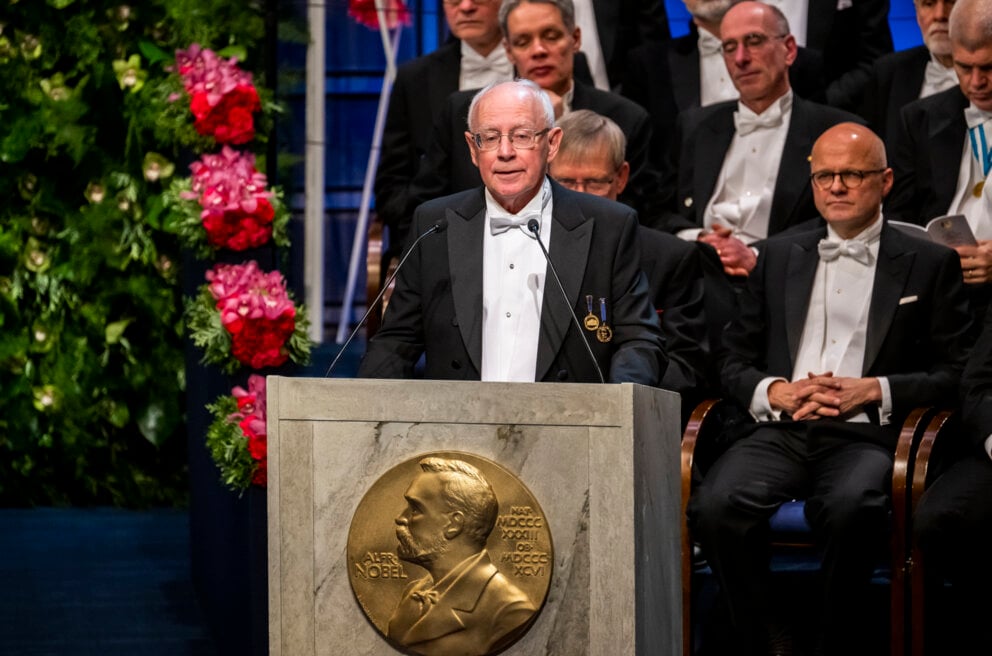Award ceremony speech

Professor Mats Larsson delivering the presentation speech for the 2022 Nobel Prize in Physics at Konserthuset Stockholm on 10 December 2022.
© Nobel Prize Outreach. Photo: Nanaka Adachi
English
Swedish
Presentation Speech by Professor Mats Larsson, Member of the Royal Swedish Academy of Sciences; Member of the Nobel Committee for Physics, 10 December 2022.
Your Majesties, Your Royal Highnesses, Esteemed Nobel Prize Laureates, Ladies and Gentlemen
This year’s Nobel Prize in Physics is dedicated to quantum mechanics. Albert Einstein, Niels Bohr and Erwin Schrödinger all thought about quantum mechanics in 1935. Einstein challenged quantum mechanics and argued that although correct, it was not a complete theory. He thought there must be an underlying structure to quantum mechanics that so far had not revealed itself. Bohr, on the other hand, defended the theory and argued that it was complete. Finally, Schrödinger concluded that entanglement between two particles with a common past was the characteristic trait of quantum mechanics.
Most physicists sided with Bohr and noted Schrödinger’s characterisation of entanglement, but mostly they were not that interested. They were too busy applying quantum mechanics to real world problems, both of fundamental character and for practical applications. Several of these practitioners of quantum mechanics would eventually receive the Nobel Prize in Physics and many of the things we today take for granted, such as streamed television, fast internet, mobile phones, and a plethora of medical diagnostics tools, all have their origins in quantum mechanics. Indeed, the laureates of 2020 and 2021 − Roger Penrose, Reinhard Genzel, Andrea Ghez, Syukuro Manabe, Klaus Hasselmann and Giorgio Parisi − are no exceptions.
While the world moved on, a few physicists continued to think about the foundations of quantum mechanics. In 1964, John Stewart Bell invented a mathematical formula, Bell’s inequality, which pointed to a way to experimentally resolve the conflict between Einstein and Bohr. Most physicists did not pay attention. Why bother with a foundational problem of quantum mechanics that would have no practical consequences? From their perspective, the theory worked. It had been well established in textbooks and taught at universities for decades. Although it was recognised that quantum entanglement was an elusive and hard-to-understand trait of quantum mechanics, few realised what it could be used for.
John Clauser was of a different opinion. When he heard about Bell’s inequality, he became obsessed with how to experimentally test it. He left his main research direction and, working with a younger colleague named Stuart Freedman, managed to perform the very first experimental test of Bell’s inequality. Their experimental effort fifty years ago, done on a shoestring budget, showed that quantum mechanics violated Bell’s inequality and that quantum mechanics correctly predicted the outcome of their experiment. Sadly, neither Bell nor Freedman is still with us today.
John Clauser’s experiment appeared convincing and suggested that Bohr was more correct than Einstein. But Bell realised that there were a few shortcomings in Clauser’s experiment, shortcomings that seemed almost impossible to overcome. It is now that Alain Aspect entered the scene. Together with colleagues in France, he managed to overcome these shortcomings and performed a series of experiments that were broadly recognised. These experiments were even highlighted in Swedish newspapers, though sometimes stretched well beyond their actual results.
The experimental test of Bell’s inequality now entered a new era, thanks to Anton Zeilinger and his collaborators. While Zeilinger and others continued to close some remaining loopholes in the Clauser and Aspect experiments, even more importantly, they demonstrated how the elusive concept of quantum entanglement can be useful. This was a giant leap from Zeilinger’s Austrian predecessor Schrödinger, and it is remarkable how the circle began in Austria and was closed in Austria. We have entered the second quantum revolution!
Professor Aspect, Dr Clauser and Professor Zeilinger,
you have been awarded the 2022 Nobel Prize in Physics “for experiments with entangled photons, establishing the violation of Bell inequalities and pioneering quantum information science”. It is an honour and a privilege to convey to you, on behalf of the Royal Swedish Academy of Sciences, our warmest congratulations. I now ask you to step forward to receive the Nobel Prize from the hands of His Majesty the King.
Copyright © The Nobel Foundation 2022
Nobel Prizes and laureates
Six prizes were awarded for achievements that have conferred the greatest benefit to humankind. The 12 laureates' work and discoveries range from proteins' structures and machine learning to fighting for a world free of nuclear weapons.
See them all presented here.
